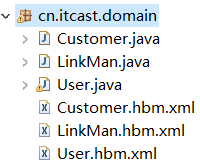一、整合原理

二、整合步骤
2.1 导包
【hibernate】
- hibernate/lib/required
- hibernate/lib/jpa
- 数据库驱动
【struts2】
- struts-blank.war/WEB-INF/lib/*(注意:javassist-3.18.1-GA.jar包与hibernate中的重复,删除版本低的)
- struts整合spring插件包

(注意:这个包一旦导入,那么struts2在启动时就会寻找spring容器,如果你导入了这个包,却没有配置spring容器,那么项目启动的时候就会抛出异常)
【spring】
- 基本(4+2):core、beans、context、expression、logging、log4j
- 整合web的包:spring-web
- 整合aop(4个):spring-aop、spring-aspect、aop联盟、aopweaving
- 整合Hibernate和事务(4个):spring-jdbc、spring-tx、c3p0、spring-orm
- junit4测试包:spring-test
2.2 单独配置spring容器
2.2.1 创建配置文件applicationContext.xml,并导入约束

<?xml version="1.0" encoding="UTF-8"?> <beans xmlns:xsi="http://www.w3.org/2001/XMLSchema-instance" xmlns="http://www.springframework.org/schema/beans" xmlns:aop="http://www.springframework.org/schema/aop" xmlns:context="http://www.springframework.org/schema/context" xmlns:tx="http://www.springframework.org/schema/tx" xsi:schemaLocation="http://www.springframework.org/schema/beans http://www.springframework.org/schema/beans/spring-beans-4.2.xsd http://www.springframework.org/schema/aop http://www.springframework.org/schema/aop/spring-aop-4.0.xsd http://www.springframework.org/schema/context http://www.springframework.org/schema/context/spring-context-4.2.xsd http://www.springframework.org/schema/tx http://www.springframework.org/schema/tx/spring-tx-4.0.xsd "> </beans>
2.2.2 在web.xml中配置spring随项目启动
<!-- 让spring随web启动而启动的监听器 --> <listener> <listener-class>org.springframework.web.context.ContextLoaderListener</listener-class> </listener> <!-- 配置spring配置文件的位置参数 --> <context-param> <param-name>contextConfigLocation</param-name> <param-value>classpath:applicationContext.xml</param-value> </context-param>
2.3 单独配置struts2
2.3.1 配置struts2主配置文件struts.xml
<?xml version="1.0" encoding="UTF-8" ?> <!DOCTYPE struts PUBLIC "-//Apache Software Foundation//DTD Struts Configuration 2.3//EN" "http://struts.apache.org/dtds/struts-2.3.dtd"> <struts> <!-- 配置一个包:package --> <package name="crm" namespace="/" extends="struts-default"> <!-- 配置Action --> <action name="UserAction_*" class="cn.itcast.web.action.UserAction" method="{1}"> <!-- 配置结果页面的跳转 --> <result name="success">/success.jsp</result> </action> </package> </struts>
2.3.2 配置struts2核心过滤器到web.xml
<!-- struts2核心过滤器 --> <filter> <filter-name>struts2</filter-name> <filter-class>org.apache.struts2.dispatcher.ng.filter.StrutsPrepareAndExecuteFilter</filter-class> </filter> <filter-mapping> <filter-name>struts2</filter-name> <url-pattern>/*</url-pattern> </filter-mapping>
2.4 struts2与spring整合
2.4.1 在struts.xml中配置常量
<!-- # struts.objectFactory = spring 将antion的创建交给spring容器 struts.objectFactory.spring.autoWire = name spring负责装配Action的依赖属性 --> <constant name="struts.objectFactory" value="spring"></constant>
2.4.2 整合
- 方案1:struts2自己创建action,spring负责组装依赖属性(不推荐,最好由spring完整管理action的生命周期.spring中的功能才能应用到Action上)
<!-- 整合方案1:class属性上仍然配置action的完整类名 struts2仍然创建action,由spring负责组装action中的依赖属性 --> <action name="UserAction_*" class="cn.itcast.web.action.UserAction" method="{1}"> <result name="success">/success.jsp</result> </action>
- 方案2:spring负责创建action以及组装。struts.xml:
<!-- 整合方案2:class属性上填写spring中action对象的BeanName 完全由spring管理action生命周期,包括Action的创建 注意:需要手动组装依赖属性 --> <action name="UserAction_*" class="userAction" method="{1}"> <result name="success">/success.jsp</result> </action>
applicationContext.xml
<!-- action --> <!-- 注意:Action对象的作用范围一定是多例的,这样才符合struts2架构 --> <bean name="userAction" class="cn.itcast.web.action.UserAction" scope="prototype"> <property name="userService" ref="userService"></property> </bean>
2.5 单独配置hibernate
2.5.1 导入实体类&orm元数据

2.5.2 配置主配置文件hibernate.cfg.xml
<?xml version="1.0" encoding="UTF-8"?> <!DOCTYPE hibernate-configuration PUBLIC "-//Hibernate/Hibernate Configuration DTD 3.0//EN" "http://www.hibernate.org/dtd/hibernate-configuration-3.0.dtd"> <hibernate-configuration> <session-factory> <!-- 数据库驱动 --> <property name="hibernate.connection.driver_class">com.mysql.jdbc.Driver</property> <!-- 数据库url --> <property name="hibernate.connection.url">jdbc:mysql:///crm</property> <!-- 数据库连接用户名 --> <property name="hibernate.connection.username">root</property> <!-- 数据库连接密码 --> <property name="hibernate.connection.password">root</property> <!-- 数据库方言 注意: MYSQL在选择方言时,请选择最短的方言. --> <property name="hibernate.dialect">org.hibernate.dialect.MySQLDialect</property> <!-- 将hibernate生成的sql语句打印到控制台 --> <property name="hibernate.show_sql">true</property> <!-- 将hibernate生成的sql语句格式化(语法缩进) --> <property name="hibernate.format_sql">true</property> <!-- 自动导出表结构. 自动建表 --> <property name="hibernate.hbm2ddl.auto">update</property> <!-- 引入实体配置文件 --> <mapping resource="cn/itcast/domain/Customer.hbm.xml" /> <mapping resource="cn/itcast/domain/LinkMan.hbm.xml" /> <mapping resource="cn/itcast/domain/User.hbm.xml" /> </session-factory> </hibernate-configuration>
2.6 spring整合hibernate
2.6.1 在spring中配置sessionFactory
- 方案一:仍然使用外部的hibernate.cfg.xml配置信息
<!-- 将SessionFactory配置到spring容器中 --> <!-- 加载配置方案1:仍然使用外部的hibernate.cfg.xml配置信息 --> <bean name="sessionFactory" class="org.springframework.orm.hibernate4.LocalSessionFactoryBean"> <property name="configLocation" value="classpath:hibernate.cfg.xml"></property> </bean>
- 方案二:在spring配置中配置hibernate配置信息
<!-- 将SessionFactory配置到spring容器中 --> <!-- 加载配置方案2:在spring配置中配置hibernate配置信息 --> <bean name="sessionFactory" class="org.springframework.orm.hibernate4.LocalSessionFactoryBean"> <!-- 配置hibernate基本信息 --> <property name="hibernateProperties"> <props> <!-- 必选配置 --> <prop key="hibernate.connection.driver_class">com.mysql.jdbc.Driver</prop> <prop key="hibernate.connection.url">jdbc:mysql:///crm</prop> <prop key="hibernate.connection.username">root</prop> <prop key="hibernate.connection.password">root</prop> <prop key="hibernate.dialect">org.hibernate.dialect.MySQLDialect</prop> <!-- 可选配置 --> <prop key="hibernate.show_sql">true</prop> <prop key="hibernate.format_sql">true</prop> <prop key="hibernate.hbm2ddl.auto">update</prop> </props> </property> <!-- 引入orm元数据,指定orm元数据所在的包路径,spring会自动读取包中的所有配置 --> <property name="mappingDirectoryLocations" value="classpath:cn/itcast/domain"></property> </bean>
2.6.2 操作数据库
- Dao类创建:继承HibernateDaoSupport
// HibernateDaoSupport 为dao注入sessionFactory public class UserDaoImpl extends HibernateDaoSupportimplements UserDao{ @Override public User getByUserCode(final String usercode) { // HQL return getHibernateTemplate().execute(new HibernateCallback<User>() { @Override public User doInHibernate(Session session) throws HibernateException { Query query = session.createQuery("from User where user_code=?"); query.setParameter(0, usercode); User user = (User) query.uniqueResult(); return user; } }); // Criteria /*DetachedCriteria dc = DetachedCriteria.forClass(User.class); dc.add(Restrictions.eq("user_code", usercode)); List<User> list = (List<User>) getHibernateTemplate().findByCriteria(dc); if(list!=null&&list.size()>0){ return list.get(0); }else{ return null; }*/ } }
- spring中配置dao
<!-- dao --> <bean name="userDao" class="cn.itcast.dao.impl.UserDaoImpl"> <!-- 注入sessionFactory --> <property name="sessionFactory" ref="sessionFactory"></property> </bean>
2.7 spring整合c3p0连接池
2.7.1 配置db.properties
jdbc.jdbcUrl=jdbc:mysql:///crm
jdbc.driverClass=com.mysql.jdbc.Driver
jdbc.user=root
jdbc.password=root
2.7.2 引入连接池到spring中
<!-- 读取db.properties文件 --> <context:property-placeholder location="classpath:db.properties"/> <!-- 配置c3p0连接池 --> <bean name="dataSource" class="com.mchange.v2.c3p0.ComboPooledDataSource"> <property name="jdbcUrl" value="${jdbc.jdbcUrl}"></property> <property name="driverClass" value="${jdbc.driverClass}"></property> <property name="user" value="${jdbc.user}"></property> <property name="password" value="${jdbc.password}"></property> </bean>
2.7.3 将连接池注入给SessionFactory
<!-- 将SessionFactory配置到spring容器中 --> <bean name="sessionFactory" class="org.springframework.orm.hibernate3.LocalSessionFactoryBean"> <!-- 将连接池注入到sessionFactory,hibernate会通过连接池获得连接 --> <property name="dataSource" ref="dataSource"></property> ... </bean>
2.8 spring的AOP事务
详细步骤见Spring学习笔记(四)—— Spring中的AOP
三、扩大session作用范围
为了避免使用懒加载时出现no-session问题,在web.xml中配置openSessionInViewFilter来扩大session的作用范围
<!-- 扩大session的作用范围 注意:任何filter一定要在struts的filter之前调用 --> <filter> <filter-name>openSessionInViewFilter</filter-name> <filter-class>org.springframework.orm.hibernate5.support.OpenSessionInViewFilter</filter-class> </filter> <filter-mapping> <filter-name>openSessionInViewFilter</filter-name> <url-pattern>/*</url-pattern> </filter-mapping>